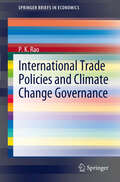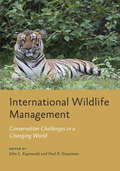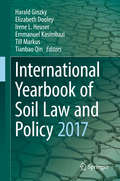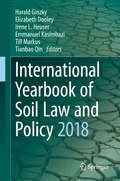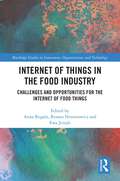- Table View
- List View
International Trade Policies and Climate Change Governance (SpringerBriefs in Economics)
by P.K. RaoThis work offers a synthesis of the current approaches toward an integration of international trade and climate change, with a view to fostering potential improvements in policies and institutions affecting these. A number of pragmatic measures are proposed with reference to the WTO and the United Nations Framework Convention on Climate Change (UNFCCC) regimes, which are expected to contribute toward enhanced climate change governance, as well as promoting international trade.
International Weather Radar Networking: Final Seminar of the COST Project 73
by C. G. CollierInternational Weather Radar Networking covers all aspects of the subject in a collection of contributions drawn from all over the world. Of particular interest are the papers describing work in Eastern Europe and papers reviewing of the achievements of the Commission of the European Communities COST-73 project. During the last twenty years there has been a rapid growth in the number of digital radars deployed for operational use in Western Europe. There are now around 100, of which about half have a Doppler capability, providing wind as well as reflectivity information. The international exchange of the data from these systems promises a great enhancement of the benefits to weather forecasting and commercial users. This volume reports work being undertaken to realize those benefits and points the way to future developments of radar technology.
International Wildlife Management: Conservation Challenges in a Changing World (Wildlife Management and Conservation)
by John L. Koprowski Paul R. KrausmanHabitat loss, disease management, predator-human conflict, illegal trade—these are among the many conservation challenges faced by wildlife experts around the world. But how wildlife professionals approach these issues has historically been geographically fragmented. By providing a broad perspective on issues faced by wildlife on an international scale, the authors of International Wildlife Management make vital connections, drawing attention to underlying causes and strategies for mitigation that may look surprisingly similar from Montana to Zimbabwe. Bringing together wildlife professionals from around the globe to discuss shared challenges, International Wildlife Management• examines widespread patterns of wildlife loss• covers key conservation strategies, including species reintroduction, community engagement, and wildlife commerce• explores the urgent concerns of climate change, habitat loss and fragmentation, invasive species, and poaching• reviews major organizations involved in wildlife management at an international level, highlighting examples of cooperation among groups and nations in effective wildlife management efforts• features stories of success and struggle from authors across 17 countries on 6 continents This timely and thorough overview thinks big by assessing threats to wildlife on a global scale. Wild creatures don't recognize artificial geographic borders. This useful compendium demonstrates that researchers and scientists should follow their lead.
International Wildlife Management: Conservation Challenges in a Changing World (Wildlife Management and Conservation)
by John L. Koprowski Paul R. KrausmanHabitat loss, disease management, predator-human conflict, illegal trade—these are among the many conservation challenges faced by wildlife experts around the world. But how wildlife professionals approach these issues has historically been geographically fragmented. By providing a broad perspective on issues faced by wildlife on an international scale, the authors of International Wildlife Management make vital connections, drawing attention to underlying causes and strategies for mitigation that may look surprisingly similar from Montana to Zimbabwe. Bringing together wildlife professionals from around the globe to discuss shared challenges, International Wildlife Management• examines widespread patterns of wildlife loss• covers key conservation strategies, including species reintroduction, community engagement, and wildlife commerce• explores the urgent concerns of climate change, habitat loss and fragmentation, invasive species, and poaching• reviews major organizations involved in wildlife management at an international level, highlighting examples of cooperation among groups and nations in effective wildlife management efforts• features stories of success and struggle from authors across 17 countries on 6 continents This timely and thorough overview thinks big by assessing threats to wildlife on a global scale. Wild creatures don't recognize artificial geographic borders. This useful compendium demonstrates that researchers and scientists should follow their lead.
International Yearbook of Soil Law and Policy 2016 (International Yearbook of Soil Law and Policy #2016)
by Harald Ginzky Irene L. Heuser Tianbao Qin Oliver C. Ruppel Patrick WegerdtThe first volume of the International Yearbook of Soil Law and Policy includes an important discussion on the implementation of the Sustainable Development Goals that are the basis for the post-2015 development agenda up to the year 2030; the Yearbook focuses in particular on Goal 15, which includes achieving a “land degradation-neutral world.” It also provides a comprehensive and highly informative overview of the latest developments at the international level, important cross-disciplinary issues and different approaches in national legislation. The book is divided into four sections. Forewords by internationally renowned academics and politicians are followed by an analysis of the content and structure of the Sustainable Development Goals with regard to soil and land as well as the scientific methods for their implementation. In addition, all relevant international regimes are discussed, including the latest developments, such as the decisions made at the 12th Conference of the Parties to the United Nations Convention to Combat Desertification (UNCCD) and the Paris Agreement on Climate Change. The next section deals with cross-disciplinary issues relevant to the implementation of the Sustainable Development Goals like the right to food, land tenure, migration and the “Economics of Land Degradation” initiative. The last section gathers reports on the development of national legislation from various nations and supra-national entities, including Brazil, China, the European Union, Mongolia, Namibia and the United States. Addressing this broad range of key topics, the book offers an indispensible tool for all academics, legislators and policymakers working in this field. The “International Yearbook of Soil Law and Policy” is a book series that discusses the central questions of law and politics with regard to the protection and sustainable management of soil and land – at the international, national and regional level.
International Yearbook of Soil Law and Policy 2017 (International Yearbook of Soil Law and Policy #2017)
by Harald Ginzky Elizabeth Dooley Irene L. Heuser Emmanuel Kasimbazi Till Markus Tianbao QinThis book presents an important discussion on soil and sustainable agriculture from a range of perspectives, addressing key topics such as sustainable intensification, the FAO Voluntary Guidelines, and the crucial role of appropriate tenure rights. This second volume of the International Yearbook of Soil Law and Policy is divided into four parts, the first of which deals with several aspects of the theme “soil and sustainable agriculture.” In turn, the second part covers recent international developments, the third part presents regional and national reports, and the fourth discusses cross-cutting issues. Given the range of key topics covered, the book offers an indispensable tool for all academics, legislators and policymakers working in this field. The “International Yearbook of Soil Law and Policy” is a book series that discusses central questions in law and politics with regard to the protection and sustainable management of soil and land – at the international, national and regional level. The Chapter "The Use of Property Law Tools for Soil Protection" by Jessica Owley is available open access under a CC BY 4.0 license at link.springer.com.
International Yearbook of Soil Law and Policy 2018 (International Yearbook of Soil Law and Policy #2018)
by Harald Ginzky Elizabeth Dooley Irene L. Heuser Emmanuel Kasimbazi Till Markus Tianbao QinThis book presents an important discussion on urbanization and sustainable soil management from a range of perspectives, addressing key topics such as sustainable cities, soil sealing, rehabilitation of contaminated soils, property rights and liability issues, as well as trading systems with regard to land take.This third volume of the International Yearbook of Soil Law and Policy is divided into four parts, the first of which explores several aspects of the topic “urbanization and sustainable management of soils.” The second part then covers recent international developments, while the third part presents regional and national reports, and the fourth discusses cross-cutting issues. Given the range of key topics covered, the book offers an indispensible tool for all academics, legislators and policymakers working in this field. The “International Yearbook of Soil Law and Policy” series discusses central questions in law and politics with regard to the protection and sustainable management of soil and land – at the international, national and regional level.
International Yearbook of Soil Law and Policy 2019 (International Yearbook of Soil Law and Policy #2019)
by Harald Ginzky Elizabeth Dooley Irene L. Heuser Emmanuel Kasimbazi Robert Kibugi Till Markus Tianbao Qin Oliver RuppelThis book presents an important discussion on the implementation of sustainable soil management in Africa from a range of governance perspectives. It addresses aspects such as the general challenges in Africa with regard to soil management; the structural deficiencies in legal, organizational and institutional terms; and specific policies at the national level, including land cover policies and persistent organic pollutants.This fourth volume of the International Yearbook of Soil Law and Policy is divided into four parts, the first of which deals with several aspects of the theme “sustainable soil management in Africa.” In turn, the second part covers recent international developments, the third part presents regional and national reports (i.a. Mexico, USA and Germany), and the fourth discusses cross-cutting issues(i.a. on rural-urban interfaces). Given the range of key topics covered, the book offers an indispensible tool for all academics, legislators and policymakers working in this field.The “International Yearbook of Soil Law and Policy” is a book series that discusses central questions in law and politics with regard to the protection and sustainable management of soil and land – at the international, national and regional level.
Internationale Politik und Governance in der Arktis: Eine Einführung
by Kathrin Stephen Sebastian Knecht Golo M. BartschErstmalig in einem deutschsprachigen Lehrbuch werden Geschichte, Akteure, Institutionen und Prozesse der internationalen Arktispolitik vor dem Hintergrund verschiedener Politikfelder sowie Theorien der internationalen Beziehungen anschaulich und verständlich analysiert. Fragen wie „Was macht die Arktis als Region in den internationalen Beziehungen aus?“, „Welche Akteure und Institutionen spielen eine Rolle in der Arktispolitik?“, „Welche Bedeutung kommt den Ressourcen und Schifffahrtswegen in einer zugänglich werdenden Arktis zu?“ und „Welche umwelt- und sicherheitspolitischen Bedenken gehen mit einer wärmeren Arktis einher?“ stehen im Zentrum aktueller wissenschaftlicher wie politischer Debatten, welchen sich dieses Buch annimmt. Es bietet damit für Einsteiger ebenso wie für fortgeschrittene Arktiskundige eine Orientierung zwischen den Extremen der historischen Romantisierung der Nordpolarregion als Niemandsland und ihrer aktuellen Charakterisierung als drohendem Konfliktraum.Das Buch beleuchtet verschiedene Konzepte und Theorieansätze aus den internationalen Beziehungen, dem internationalen Recht und der politischen Geografie und unterzieht sie einem Eignungstest für die Erklärung arktispolitischer Vorgänge in den Bereichen Ressourcen-, Umwelt- und Sicherheitspolitik. Damit liefert es akademische wie praxisrelevante Orientierung für jeden, der politische Prozesse in der Arktis anhand konkreter theoretischer Annahmen zu verstehen sucht, und gibt Anregungen und Impulse für zukünftige Forschungsarbeit.
Internationale Umweltregime: Umweltschutz durch Verhandlungen und Verträge
by Thomas Gehring Sebastian OberthürInternationaler Meteorologischer Kodex
by Gustav Hellmann Hugo Hildebrand HildebrandssonDieser Buchtitel ist Teil des Digitalisierungsprojekts Springer Book Archives mit Publikationen, die seit den Anfängen des Verlags von 1842 erschienen sind. Der Verlag stellt mit diesem Archiv Quellen für die historische wie auch die disziplingeschichtliche Forschung zur Verfügung, die jeweils im historischen Kontext betrachtet werden müssen. Dieser Titel erschien in der Zeit vor 1945 und wird daher in seiner zeittypischen politisch-ideologischen Ausrichtung vom Verlag nicht beworben.
Internationaler Naturschutz
by Karl-Heinz ErdmannEin internationales, interdisziplinäres Autorenteam erläutert hier aktuelle Problemstellungen aus dem Bereich des Naturschutzes. Die einzelnen Beiträge befassen sich u.a. mit folgenden Themen: Die Rolle der UNESCO bei der Förderung des internationalen Naturschutzes; trilaterale Zusammenarbeit beim Schutz des Wattenmeers; CITES - das Washingtoner Artenschutzübereinkommen; gesellschaftliche Dimensionen globaler Klimaveränderungen; Stand des Naturschutzes in verschiedenen Ländern Europas, Afrikas und Asiens; politische Perspektiven des internationalen Naturschutzes etc..
Internationalization, Innovation and Sustainability of MNCs in Latin America (AIB Latin America)
by Leonardo LibermanPresents research findings and theoretical developments in the International Business field, with special emphasis on the issues of internationalization, innovation and sustainability in Latin America.
The Internet as a Technology-Based Ecosystem: A New Approach to the Analysis of Business, Markets and Industries
by Nigel WaltonThis book examines and critiques classical approaches to strategic analysis, whilst exploring alternative methods which utilise ecosystem and platform concepts, as well as chaos and complexity theories. The innovative study provides a critique of the neoclassical Newtonian school of strategy, and proves it to be largely inappropriate as a decision-making methodology in today’s internet-based market. By developing a new biological hydrothermal vent model in which analogical comparisons are made with the Information Communication Technology (ICT) sector, the chapters challenge existing paradigms of competitive advantage and analyse the extent to which the Internet can be considered to be an ecosystem in its own right. The Internet as a Technology-Based Eco-System offers a range of alternative models and analytical frameworks for the analysis of internet-based technology companies in the twenty-first century, creating a valuable tool for students and academics undertaking research in strategy, technology and electronic engineering.
The Internet as Second Action Space
by Aharon KellermanOne of the most significant and important advancements in information and communication technology over the past 20 years is the introduction and expansion of the Internet. Now almost universally available, the Internet brings us email, global voice and video communications, research repositories, reference libraries, and almost unlimited opportunities for daily activities. Bridging geographical distances in unprecedented ways, the Internet has impacted all aspects of our daily lives – from facilitating the running of businesses, the attainment of services and keeping in touch with friends and family. Accessible at any time and for many of us from our mobile phones, the Internet has opened up a world of knowledge and communication platforms that we cannot now imagine living without. This book explores the concept that the Internet has become a second action space for individuals. Coexisting with traditional and "obvious" real space, the Internet serves as a novel spatial platform and action space to its subscribers all over the world. Kellerman expertly discusses this notion and examines the practical integration of cyberspace with real space. Part I examines the Internet as a platform for action and presents its relations with physical space concerning a range of uses and applications which were traditionally performed in physical space only. It discusses the idea that the Internet has become a second space and explores theoretical perspectives surrounding this notion. The Internet has undeniably made humankind more efficient and connected. Part II explores the Internet as an action space for human life, considering basic human needs, curiosity, identity and social relations. It further considers instances whereby use and application of the Internet cannot be fully performed in real space, mainly regarding people’s presentation of identity. Part III explores daily actions over the Internet, such as work, shopping, banking and social interactions. Kellerman also briefly touches on the darker aspects that the expansion of the Internet has made possible – including its role in fraud and other crimes. The concluding chapter discusses people living across the two spaces and identifies potential future developments. The Internet as Second Actions Space will appeal to students across the social sciences, in particular those studying Geography, Sociology, Media Studies, Internet Studies, Business and related disciplines.
The Internet as Second Action Space
by Aharon KellermanOne of the most significant and important advancements in information and communication technology over the past 20 years is the introduction and expansion of the Internet. Now almost universally available, the Internet brings us email, global voice and video communications, research repositories, reference libraries, and almost unlimited opportunities for daily activities. Bridging geographical distances in unprecedented ways, the Internet has impacted all aspects of our daily lives – from facilitating the running of businesses, the attainment of services and keeping in touch with friends and family. Accessible at any time and for many of us from our mobile phones, the Internet has opened up a world of knowledge and communication platforms that we cannot now imagine living without. This book explores the concept that the Internet has become a second action space for individuals. Coexisting with traditional and "obvious" real space, the Internet serves as a novel spatial platform and action space to its subscribers all over the world. Kellerman expertly discusses this notion and examines the practical integration of cyberspace with real space. Part I examines the Internet as a platform for action and presents its relations with physical space concerning a range of uses and applications which were traditionally performed in physical space only. It discusses the idea that the Internet has become a second space and explores theoretical perspectives surrounding this notion. The Internet has undeniably made humankind more efficient and connected. Part II explores the Internet as an action space for human life, considering basic human needs, curiosity, identity and social relations. It further considers instances whereby use and application of the Internet cannot be fully performed in real space, mainly regarding people’s presentation of identity. Part III explores daily actions over the Internet, such as work, shopping, banking and social interactions. Kellerman also briefly touches on the darker aspects that the expansion of the Internet has made possible – including its role in fraud and other crimes. The concluding chapter discusses people living across the two spaces and identifies potential future developments. The Internet as Second Actions Space will appeal to students across the social sciences, in particular those studying Geography, Sociology, Media Studies, Internet Studies, Business and related disciplines.
Internet of Things for Facility Management: Strategies of Service Optimization and Innovation (SpringerBriefs in Applied Sciences and Technology)
by Nazly AttaThis book proposes strategies for FM services optimization and innovation, based on innovative models of IoT application and big data management within FM processes, able to support FM stakeholders in: orienting and managing big data flows and their sources (sensor, RFID, etc.); changing FM services demand/offer and developing new approaches to FM agreements; drawing new supply chains based on network approaches; and outlining new profiles of competences for FM stakeholders. The book demonstrates that FM stakeholders (e.g. Real Estate owners, FM providers, service suppliers, etc.) increasingly need new support tools for understanding the features of the current offer of innovative ICT solutions in order to become promoters of FM innovation, and it provides them with an analytical-procedural framework useful for defining and implementing IoT-based FM services.
Internet of Things in Smart Technologies for Sustainable Urban Development (EAI/Springer Innovations in Communication and Computing)
by R. Maheswar G. R. Kanagachidambaresan V. Manikandan K. RamakrishnanThis book provides solution for challenges facing engineers in urban environments looking towards smart development and IoT. The authors address the challenges faced in developing smart applications along with the solutions. Topics addressed include reliability, security and financial issues in relation to all the smart and sustainable development solutions discussed. The solutions they provide are affordable, resistive to threats, and provide high reliability. The book pertains to researchers, academics, professionals, and students.Provides solutions to urban sustainable development problems facing engineers in developing and developed countriesDiscusses results with industrial problems and current issues in smart city developmentIncludes solutions that are reliable, secure and financially sound
Internet of Things in the Food Industry: Challenges and Opportunities for the Internet of Food Things (Routledge Studies in Innovation, Organizations and Technology)
by Anna RogalaThe food industry is experiencing a digital transformation across the entire supply chain, from farm to fork. This book offers comprehensive insights into the challenges and opportunities faced, specifically examining the application of the Internet of Things. The authors analyse the benefits and the related threats from the perspective of the participants of the entire supply chain, including consumers. Taking the reader on a journey, this book begins with an analysis of technology use in farming, production, logistics and retailing before delving into the use of digitalization in educating consumers on sustainable consumption practices. The multifaceted analysis of the Internet of Food potential combines science and practice, enriching theoretical analysis with case studies. This book will be of interest to those researching and studying supply chain management, logistics, innovation and technology management and consumption, with a particular interest in the food industry.
Internet of Things in the Food Industry: Challenges and Opportunities for the Internet of Food Things (Routledge Studies in Innovation, Organizations and Technology)
The food industry is experiencing a digital transformation across the entire supply chain, from farm to fork. This book offers comprehensive insights into the challenges and opportunities faced, specifically examining the application of the Internet of Things. The authors analyse the benefits and the related threats from the perspective of the participants of the entire supply chain, including consumers. Taking the reader on a journey, this book begins with an analysis of technology use in farming, production, logistics and retailing before delving into the use of digitalization in educating consumers on sustainable consumption practices. The multifaceted analysis of the Internet of Food potential combines science and practice, enriching theoretical analysis with case studies. This book will be of interest to those researching and studying supply chain management, logistics, innovation and technology management and consumption, with a particular interest in the food industry.
Interoperating Geographic Information Systems (The Springer International Series in Engineering and Computer Science #495)
by Michael Goodchild Max J. Egenhofer Robin Fegeas Cliff KottmanGeographic information systems have developed rapidly in the past decade, and are now a major class of software, with applications that include infrastructure maintenance, resource management, agriculture, Earth science, and planning. But a lack of standards has led to a general inability for one GIS to interoperate with another. It is difficult for one GIS to share data with another, or for people trained on one system to adapt easily to the commands and user interface of another. Failure to interoperate is a problem at many levels, ranging from the purely technical to the semantic and the institutional. Interoperating Geographic Information Systems is about efforts to improve the ability of GISs to interoperate, and has been assembled through a collaboration between academic researchers and the software vendor community under the auspices of the US National Center for Geographic Information and Analysis and the Open GIS Consortium Inc. It includes chapters on the basic principles and the various conceptual frameworks that the research community has developed to think about the problem. Other chapters review a wide range of applications and the experiences of the authors in trying to achieve interoperability at a practical level. Interoperability opens enormous potential for new ways of using GIS and new mechanisms for exchanging data, and these are covered in chapters on information marketplaces, with special reference to geographic information. Institutional arrangements are also likely to be profoundly affected by the trend towards interoperable systems, and nowhere is the impact of interoperability more likely to cause fundamental change than in education, as educators address the needs of a new generation of GIS users with access to a new generation of tools. The book concludes with a series of chapters on education and institutional change. Interoperating Geographic Information Systems is suitable as a secondary text for graduate level courses in computer science, geography, spatial databases, and interoperability and as a reference for researchers and practitioners in industry, commerce and government.
Interoperating Geographic Information Systems: Second International Conference, INTEROP'99, Zurich, Switzerland, March 10-12, 1999 Proceedings (Lecture Notes in Computer Science #1580)
by Andrej Vckovski Kurt E. Brassel Hans-Jörg SchekInterplanetary Dust (Astronomy and Astrophysics Library)
by Eberhard Grün Bo A. S. Gustafson Stan. Dermott Hugo FechtigAn excellent handbook on the physics of interplanetary dust, a topic of interest not only to astronomers and space scientists but also to engineers. The following topics are covered in the book: historical perspectives; cometary dust; near-Earth environment; meteoroids and meteors; properties of interplanetary dust, information from collected samples; in situ measurements of cosmic dust; numerical modeling of the Zodiacal Cloud structure; synthesis of observations; instrumentation; physical processes; optical properties of interplanetary dust; orbital evolution of interplanetary dust; circumplanetary dust, observations and simple physics; interstellar dust and circumstellar dust disks. No doubt, the text will be regarded as the standard reference on interplanetary dust for many years to come.
Interplanetary Outpost: The Human and Technological Challenges of Exploring the Outer Planets (Springer Praxis Books)
by Erik Seedhouse"Interplanetary Outpost" follows the mission architecture template of NASA's plan for Human Outer Planet Exploration (HOPE), which envisions sending a crew to the moon Callisto to conduct exploration and sample return activities. To realize such a mission, the spacecraft will be the most complex interplanetary vehicle ever built, representing the best technical efforts of several nations. A wealth of new technologies will need to be developed, including new propulsion systems, hibernation strategies, and revolutionary radiation shielding materials. Step by step, the book will describe how the mission architecture will evolve, how crews will be selected and trained, and what the mission will entail from launch to landing. However, the focus of "Interplanetary Outpost" is on the human element. The extended duration, logistical challenges, radiation concerns, communication lag times, isolation, and deleterious effects on the human body will conspire to not only significantly impair human performance but also affect the behavior of crewmembers. This book addresses each of these issues in detail while still providing the reader with a background to the necessary elements comprising such a mission.
The Interplay between Urban Development, Vulnerability, and Risk Management: A Case Study of the Istanbul Metropolitan Area (SpringerBriefs in Environment, Security, Development and Peace #7)
by Ebru A. GencerNatural disasters are increasingly affecting the world, taking lives unexpectedly and leaving many others injured and homeless. Moreover, disasters disrupt local, national and even global economies, instantly changing the direction of development. In the first half of 2011 alone, 108 natural disasters occurred, killing over 23 thousand people, affecting nearly 44 million others and causing more than 253 billion US dollars of economic damages (CRED 2011,1). Large urban settlements have become increasingly vulnerable to the impacts of natural disasters. The concentration of substandard infrastructure and housing, material assets, and inherent socio-economic inequalities increase vulnerability to disasters in large urban areas, especially in developing countries. The size, number, functions, and geographical distribution of large- and megacities create a special concern for disaster risk. Good urban management practices can be a powerful catalyst for reducing losses from natural disasters, while simultaneously helping to develop a sustainable environment. Yet, the existing situation indicates that sustainable planning and risk management measures are not taken into consideration or may not be put into practice for a variety of financial, political, and social reasons. This book argues that, on one hand, socio-economic disparities resulting from unsustainable urban development can increase vulnerability to natural hazards, and on the other hand, when paired with natural hazards this increased vulnerability can negatively affect urban areas, resulting in further inequality. This book will showcase this argument with theoretical reviews and quantitative analyses on the interplay between sustainable development and disaster vulnerability as well as an in-depth case study of the role of urban planning and risk management practices in creating the socio-economic and spatial vulnerabilities and predicted earthquake risk in the megacity of Istanbul.
